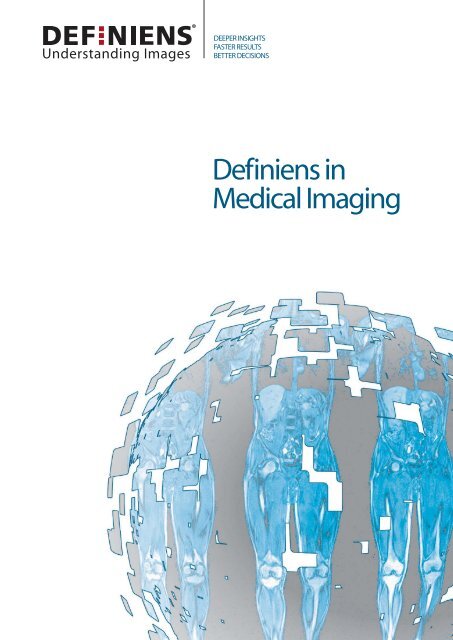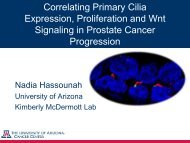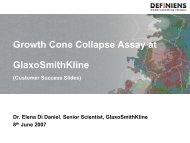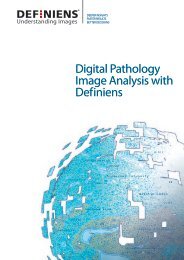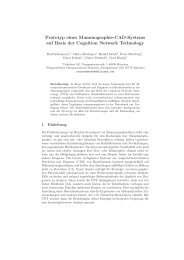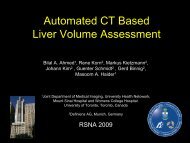Definiens in Medical Imaging
Definiens in Medical Imaging
Definiens in Medical Imaging
You also want an ePaper? Increase the reach of your titles
YUMPU automatically turns print PDFs into web optimized ePapers that Google loves.
Understand<strong>in</strong>g Images<br />
DEEPER INSIGHTS<br />
FASTER RESULTS<br />
BETTER DECISIONS<br />
<strong>Def<strong>in</strong>iens</strong> <strong>in</strong><br />
<strong>Medical</strong> Imag<strong>in</strong>g
2<br />
The Challenge <strong>in</strong><br />
<strong>Medical</strong> Imag<strong>in</strong>g<br />
<strong>Medical</strong> imag<strong>in</strong>g helps to detect, identify and observe tumors<br />
over time. Screen<strong>in</strong>g, for example, is the first l<strong>in</strong>e of defense<br />
aga<strong>in</strong>st breast cancer. CT and MRI scans are vital diagnostic<br />
tools. Biopsies help to determ<strong>in</strong>e whether lesions are malig-<br />
nant or benign. And, once treatment has begun, medical<br />
imag<strong>in</strong>g is one of the most powerful tools for measur<strong>in</strong>g<br />
therapeutic response.<br />
The proliferation of image data <strong>in</strong> oncology has created some major challenges.<br />
First and foremost, there is a global shortage of tra<strong>in</strong>ed radiologists and histopathologists.<br />
Without them, the <strong>in</strong>creas<strong>in</strong>g number of scans and tissue samples cannot<br />
be analyzed, creat<strong>in</strong>g an ‘image analysis bottleneck’ that delays the diagnosis and<br />
treatment of patients.<br />
Secondly, the task is very complex. Due to the <strong>in</strong>herent variability of liv<strong>in</strong>g organisms,<br />
even the most detailed scans can be difficult to <strong>in</strong>terpret. As we strive to detect a<br />
cancer ever earlier, many tumors are so small and escape easy detection. The Journal<br />
for Thoracic Imag<strong>in</strong>g noted, <strong>in</strong> a study evaluat<strong>in</strong>g the detection of small pulmonary<br />
nodules, that: “Observer detection of pulmonary nodules <strong>in</strong> the range of 5-15mm<br />
us<strong>in</strong>g current digital radiography systems is not reliable <strong>in</strong> the confus<strong>in</strong>g environment<br />
of the lung.” 1<br />
Spott<strong>in</strong>g lesions and tumors requires concentration, tra<strong>in</strong><strong>in</strong>g and a very good eye. In<br />
this challeng<strong>in</strong>g <strong>in</strong>terpretive environment, human error is compounded by fatigue<br />
and an overload of data.<br />
Taken together, these challenges delay detection, diagnosis and treatment.This causes<br />
unnecessary patient suffer<strong>in</strong>g and results <strong>in</strong> more costly and less effective treatment.<br />
Screen<strong>in</strong>g Diagnostic Stag<strong>in</strong>g Therapy Follow-up<br />
e.g. Mammography e.g. CT Colonoscopy e.g. Mammography e.g. CT Colonoscopy e.g. Whole Body MR<br />
Figure 1 Patient diagnostic and treatment paradigm<br />
Early diagnosis starts with screen<strong>in</strong>g, followed by diagnostic tests if suspicious lesions are found. In the case of malignant<br />
f<strong>in</strong>d<strong>in</strong>gs the stag<strong>in</strong>g phase will be used to size and locate tumors which may be treated with surgical, chemical or radiation<br />
therapy or a comb<strong>in</strong>ation. Follow<strong>in</strong>g the treatment a “re-stag<strong>in</strong>g” evaluates the success of therapy.<br />
<strong>Def<strong>in</strong>iens</strong> <strong>in</strong> <strong>Medical</strong> Imag<strong>in</strong>g<br />
1 Wu, N, et al.Vol. 21 (1): pp27-31. March 2006. Available at: www.ncbi.nlm.nih.gov/pubmed/16538152.
<strong>Medical</strong> Imag<strong>in</strong>g<br />
<strong>in</strong> Oncology<br />
<strong>Def<strong>in</strong>iens</strong>’ software can be used to complement or improve any exist<strong>in</strong>g imag<strong>in</strong>g<br />
system. It is easily <strong>in</strong>corporated <strong>in</strong>to current systems to provide an enhanced level of<br />
image <strong>in</strong>telligence. This enables medical professionals to detect cancer earlier and<br />
supports them <strong>in</strong> mak<strong>in</strong>g the best decisions to provide personalized treatment for<br />
patients.<br />
The benefits <strong>in</strong> oncology<br />
<strong>Def<strong>in</strong>iens</strong>’ technology is ideally suited to screen, identify, diagnose and treat cancer<br />
<strong>in</strong> four ways. The technology <strong>in</strong>creases sensitivity, improves consistency, <strong>in</strong>creases<br />
productivity, and accurately measures the volume of tumors help<strong>in</strong>g to assess the<br />
efficacy of treatment.<br />
As a result, <strong>Def<strong>in</strong>iens</strong>’ technology helps cl<strong>in</strong>icians and specialists to identify tumors<br />
earlier, make better treatment decisions and assess the efficacy of treatment<br />
more accurately. The cost of treatment is reduced and patients benefit from earlier<br />
<strong>in</strong>tervention and improved treatment.<br />
Example: Automatic segmentation of the liver<br />
In 20 datasets, represent<strong>in</strong>g a large variation of pathological cases, the liver was<br />
automatically segmented. In each case, the result<strong>in</strong>g segmentation was evaluated<br />
us<strong>in</strong>g the manual annotation generated jo<strong>in</strong>tly by two medical experts.<br />
<strong>Def<strong>in</strong>iens</strong>’ technology achieved an average volumetric error of 7.6% and an average<br />
mean surface distance of 2.73mm. In view of the short prototype development time<br />
(less than 30 days) the performance was good and several issues were observed for<br />
future development.<br />
A potential source of error is lesions, which may be <strong>in</strong>itially misclassified as air or fat<br />
and therefore not subject to the “dark object <strong>in</strong>clusion” process. Both these issues have<br />
been addressed <strong>in</strong> a later version of the software.<br />
The potential of <strong>Def<strong>in</strong>iens</strong> Cognition<br />
Network Technology® to deliver<br />
auto mated, precise and robust 3D<br />
detection of liver was demonstrated<br />
even <strong>in</strong> pathological cases. The<br />
abi li ty to <strong>in</strong>corporate explicit doma<strong>in</strong><br />
knowledge and context <strong>in</strong> a<br />
simple form is unique and, <strong>in</strong> our<br />
op<strong>in</strong>ion, a mandatory feature for the<br />
development of complex solutions.<br />
These solutions relieve radiologists of<br />
many mundane image analysis tasks<br />
and enable them to focus precious<br />
time on the diagnosis and treatment<br />
of patients.<br />
Figure 2 Screenshot show<strong>in</strong>g analysis of 20 Liver Samples. a) Directory with 20 images, b) Transversal 2D display,<br />
detected liver segments outl<strong>in</strong>ed <strong>in</strong> red, c) Process hierarchy of anatomical model, d) 3D visualization of segmented liver,<br />
e) Information on selected liver image<br />
<strong>Def<strong>in</strong>iens</strong> <strong>in</strong> <strong>Medical</strong> Imag<strong>in</strong>g 3
4<br />
<strong>Def<strong>in</strong>iens</strong> <strong>in</strong> <strong>Medical</strong> Imag<strong>in</strong>g<br />
Computer Aided<br />
Detection<br />
“Automatic volumetry and segmentation allows reliable detection<br />
of tumor growth and has the potential to <strong>in</strong>crease<br />
reliability and significance of monitor<strong>in</strong>g growth <strong>in</strong> follow-up<br />
exam<strong>in</strong>ations.” 2<br />
International Journal of Computer-Assisted Radiology and Surgery<br />
Studies have shown that CAD systems aim to identify and volumetrically measure<br />
different types of tumors and polyps. They have proven to be as accurate as many<br />
tra<strong>in</strong>ed experts.<br />
In a colonography study reported <strong>in</strong> the American Journal of Roentgenology, experts<br />
concluded that a CAD system’s standalone performance exceeds human standards,<br />
and that it should be used synergistically with experts. 3<br />
Volumetric measurement<br />
Volumetric measurement is by far the most accurate way of measur<strong>in</strong>g tumor size<br />
which, <strong>in</strong> turn, is a key <strong>in</strong>dicator of whether the disease is respond<strong>in</strong>g to treatment,<br />
stabiliz<strong>in</strong>g or progress<strong>in</strong>g.<br />
A study <strong>in</strong> The Journal of Cl<strong>in</strong>ical Oncology compared RECIST predictions to accurate<br />
volumetric measurements. RECIST correctly predicted volumetric response or progression<br />
<strong>in</strong> 12 out of 17 cases; and <strong>in</strong> 3 of these 12 cases it needed one or two additional<br />
scan cycles.<br />
The delay identify<strong>in</strong>g cases where the tumor was progress<strong>in</strong>g was particularly<br />
noticeable: RECIST was only 50 per cent specific for progressive disease at the<br />
time that the progression was documented with volume. This means that 8 out of<br />
17 cases (just under 50 per cent) were not assessed as quickly as they might have been. 4<br />
Such delays may be vital to a patient’s chances of survival.<br />
Figure 3 Automatically detected and classified organs and lymph nodes <strong>in</strong> an axial view CT image<br />
2 ‘OncoTREAT: a software assistant for cancer therapy monitor<strong>in</strong>g’. Borneman, Lars, et al. Vol. 1 (5): pp231-242 (February 2007). Available at: www.spr<strong>in</strong>gerl<strong>in</strong>k.<br />
com/content/1518220748810553/.<br />
3 ‘Computer-Assisted Reader Software Versus Expert Reviewers for Polyp Detection On CT Colonography.’<br />
4 Jaffe, Carl C.Vol. 24 (20): pp3245-3251. July 10 2006. Available at: http://jco.ascopubs.org/cgi/content/abstract/ 24/20/3245
Information<br />
Centric Healthcare<br />
One of the most powerful tools <strong>in</strong> support<strong>in</strong>g decision mak<strong>in</strong>g<br />
is the comparison of a case with a database of similar disease<br />
and patient patterns. This database conta<strong>in</strong>s consolidated<br />
multi-modal diagnostic tests paired with patient <strong>in</strong>formation<br />
(like risk profile, disease history, genetic profile) and thus<br />
serves as a knowledge base.<br />
<strong>Def<strong>in</strong>iens</strong>’ technology offers image analysis solutions that deliver accurate and<br />
consistent results. It extracts objects and creates hierarchical levels of classifi cation<br />
represent<strong>in</strong>g networked objects of <strong>in</strong>terest on different scales.<br />
A wide variety of decisive morphological parameters can be measured and exported<br />
<strong>in</strong>clud<strong>in</strong>g spectral statistics, shape, size, position, texture and relations to neighbor<br />
objects, sub objects and super objects.<br />
The scaleable platform can handle image analysis tasks of any size, quickly, accurately<br />
and consistently.<br />
In pre-cl<strong>in</strong>ical studies where <strong>Def<strong>in</strong>iens</strong>’ technology has been deployed, it has saved<br />
between 60-90 % of the project’s image analysis costs. That is without consider<strong>in</strong>g<br />
the vast sav<strong>in</strong>gs made where problems are identified early and a drug never enters<br />
cl<strong>in</strong>ical trials.<br />
Full-Size Size DICOM, four Views Detection of calcifications and masses, export<br />
image object statistics and patient metadata to CSV<br />
Patient search <strong>in</strong> <strong>Def<strong>in</strong>iens</strong> Developer Image object statistics (Exel)<br />
Figure 4 Process<strong>in</strong>g workflow for analysis of multimodal mammography images and tables.<br />
<strong>Def<strong>in</strong>iens</strong> <strong>in</strong> <strong>Medical</strong> Imag<strong>in</strong>g 5
6<br />
<strong>Def<strong>in</strong>iens</strong> <strong>in</strong> <strong>Medical</strong> Imag<strong>in</strong>g<br />
Example: Case-based retrieval <strong>in</strong> mammography<br />
<strong>Def<strong>in</strong>iens</strong> developed a prototype which extracts breast, nipples, calcifi cations and<br />
masses from x-ray mammograms. The statistical results can be used for a similarity<br />
search <strong>in</strong> a case database.<br />
The image data is analyzed via the follow<strong>in</strong>g steps:<br />
1. Accurate segmentation of object of <strong>in</strong>terest<br />
2. Detection and classification of masses and calcifications and creation of typical<br />
f<strong>in</strong>gerpr<strong>in</strong>t <strong>in</strong>clud<strong>in</strong>g lesion morphology<br />
3. Record<strong>in</strong>g the results <strong>in</strong> a table<br />
4. Comparison of the actual case with similar cases <strong>in</strong> the table<br />
5. Presentation of similar cases<br />
The Results<br />
The prototype was applied to 28 cancer cases. In 6 cases, clustered calcifications were<br />
the only <strong>in</strong>dications of cancer. In 8 cases malignant masses <strong>in</strong>dicated cancer. The<br />
rema<strong>in</strong><strong>in</strong>g 14 cases had calcifications with<strong>in</strong> masses.<br />
The <strong>Def<strong>in</strong>iens</strong>‘ approach detected at least one cancer region <strong>in</strong> 92.9 % of the cancer<br />
cases.Where there were malignant calcification clusters, the algorithm detected at least<br />
one cluster <strong>in</strong> all cases. The detection rate for cancer cases that conta<strong>in</strong>ed malignant<br />
masses was 90.9 %.<br />
In a multi-modal approach, images from different image modalities are analyzed<br />
<strong>in</strong> parallel. The correspond<strong>in</strong>g prototype can l<strong>in</strong>k tumor objects to correspond<strong>in</strong>g<br />
objects <strong>in</strong> images of the same or a different modality. Representative statistical results,<br />
for example on tumor morphology can be exported to support an expert’s diagnosis.<br />
Conclusions<br />
The results on different data modalities perform<strong>in</strong>g Computer Aided Detection of<br />
breast lesions look very promis<strong>in</strong>g. The technology will be the basis for the creation<br />
of new generation of CAD Systems, not only for the breast, but also for other organs by<br />
us<strong>in</strong>g different patient-relevant data <strong>in</strong> parallel.<br />
Figure 5 Screenshot of l<strong>in</strong>ked image <strong>in</strong>formation, with<br />
a1) US-, a2) x-ray- and a3) MR-mammography, analyzed<br />
by us<strong>in</strong>g a CNL prototype, which consists of a process<br />
hierarchy b1) and a class hierarchy b2). Tumors are l<strong>in</strong>ked<br />
to each other (outl<strong>in</strong>ed <strong>in</strong> red)<br />
Acknowledgment<br />
This work was supported by the Bayerische For schungsstiftung<br />
with<strong>in</strong> the scope of the project Mammo-iCAD.
Better Decisions Faster Results Deeper Insights<br />
The <strong>Def<strong>in</strong>iens</strong> Edge<br />
<strong>Def<strong>in</strong>iens</strong> Cognition Network Technology® surpasses every other<br />
automated image analysis system today across n<strong>in</strong>e different criteria<br />
deliver<strong>in</strong>g deeper <strong>in</strong>sights, faster results and better decisions.<br />
<strong>Def<strong>in</strong>iens</strong> handles complex real world situations.<br />
The multi-scale object network can explore an image, the objects <strong>in</strong> it and the relations between<br />
them simultaneously on multiple levels. The technology can even detect anomalies like abnormal<br />
cells <strong>in</strong> a tumor.<br />
<strong>Def<strong>in</strong>iens</strong> supports all common types of imag<strong>in</strong>g systems.<br />
<strong>Def<strong>in</strong>iens</strong>’ technology <strong>in</strong>terprets all types and comb<strong>in</strong>ations of digital image data. This <strong>in</strong>cludes all<br />
the major automated microscopes, digital slide scanners and non-<strong>in</strong>vasive imag<strong>in</strong>g scanners <strong>in</strong> the<br />
life sciences.<br />
<strong>Def<strong>in</strong>iens</strong> provides detailed quantification of images.<br />
<strong>Def<strong>in</strong>iens</strong>’ technology provides users with detailed morphometric quantification of any type of<br />
images for any type of task, reduc<strong>in</strong>g or elim<strong>in</strong>at<strong>in</strong>g tedious manual analysis. The extracted data can<br />
be correlated aga<strong>in</strong>st molecular data, significantly <strong>in</strong>creas<strong>in</strong>g the level of <strong>in</strong>sight.<br />
<strong>Def<strong>in</strong>iens</strong>’ applications can be developed <strong>in</strong> a fast and modular way.<br />
Applications can be developed rapidly by comb<strong>in</strong><strong>in</strong>g exist<strong>in</strong>g ruleware modules. Complex tasks can<br />
be addressed with the full power of <strong>Def<strong>in</strong>iens</strong> Cognition Network Technology®, which <strong>in</strong> turn creates<br />
ruleware that can easily be reused <strong>in</strong> other situations.<br />
<strong>Def<strong>in</strong>iens</strong>’ applications identify the areas and structures of <strong>in</strong>terest reliably.<br />
<strong>Def<strong>in</strong>iens</strong>’ technology can extract any k<strong>in</strong>d of structures <strong>in</strong> image data – even under difficult<br />
circumstances and <strong>in</strong> difficult cases. This is the key to its success <strong>in</strong> analyz<strong>in</strong>g and provid<strong>in</strong>g detailed<br />
quantification of image content.<br />
<strong>Def<strong>in</strong>iens</strong> enables fully automated <strong>in</strong>formation extraction.<br />
<strong>Def<strong>in</strong>iens</strong>’ technology offers completely automated image analysis. Its user-friendly <strong>in</strong>terfaces assist<br />
scientists and bio-<strong>in</strong>formaticians to extract <strong>in</strong>formation efficiently. <strong>Def<strong>in</strong>iens</strong> provides the perfect<br />
platform for high throughput analysis of image data.<br />
<strong>Def<strong>in</strong>iens</strong> provides reliable <strong>in</strong>formation for decision mak<strong>in</strong>g.<br />
The determ<strong>in</strong>istic approach of <strong>Def<strong>in</strong>iens</strong>’ technology ensures that all results are transparent and fully<br />
reproducible. The results can be presented <strong>in</strong> the format best suited for the decision mak<strong>in</strong>g process:<br />
as labeled regions <strong>in</strong> the image, as objects saved <strong>in</strong> a database or as statistical summaries.<br />
<strong>Def<strong>in</strong>iens</strong> <strong>in</strong>tegrates image <strong>in</strong>telligence across exist<strong>in</strong>g processes.<br />
<strong>Def<strong>in</strong>iens</strong>’ technology is highly scalable, features a modular design and <strong>in</strong>tegrates easily <strong>in</strong>to any<br />
environment. Its distributed architecture enables it to be deployed across the entire enterprise,<br />
support<strong>in</strong>g end-to-end decision mak<strong>in</strong>g processes and help<strong>in</strong>g to realize the vision of translational<br />
medic<strong>in</strong>e.<br />
<strong>Def<strong>in</strong>iens</strong> will cont<strong>in</strong>ue to lead the field.<br />
The unique patented software, built on an open standards-based architecture, is a new paradigm <strong>in</strong><br />
automated image analysis. Gerd B<strong>in</strong>nig and his team cont<strong>in</strong>ue to lead the research and development at<br />
<strong>Def<strong>in</strong>iens</strong>, ensur<strong>in</strong>g that the technology will rema<strong>in</strong> at the forefront of enterprise image <strong>in</strong>telligence.<br />
<strong>Def<strong>in</strong>iens</strong> <strong>in</strong> <strong>Medical</strong> Imag<strong>in</strong>g 7
DEEPER INSIGHTS<br />
FASTER RESULTS<br />
Understand<strong>in</strong>g Images BETTER DECISIONS<br />
<strong>Def<strong>in</strong>iens</strong> is the number one Enterprise Image Intelligence company for analyz<strong>in</strong>g and <strong>in</strong>terpret<strong>in</strong>g images<br />
on every scale, from microscopic cell structures to satellite images.<br />
The patented <strong>Def<strong>in</strong>iens</strong> Cognition Network Technology®, developed by Nobel Laureate Prof. Gerd B<strong>in</strong>nig<br />
and his team, emulates human cognitive processes of perception to extract <strong>in</strong>telligence from images.<br />
If you are <strong>in</strong>terested <strong>in</strong> learn<strong>in</strong>g more about how <strong>Def<strong>in</strong>iens</strong> could address the challenges you face, please<br />
visit our website.<br />
www.def<strong>in</strong>iens.com<br />
Corporate Headquarters Americas Headquarters<br />
<strong>Def<strong>in</strong>iens</strong> AG <strong>Def<strong>in</strong>iens</strong> Inc<br />
Trappentreustrasse 1 55 Madison Avenue, Suite 400<br />
80339 München Morristown, NJ 07960<br />
Germany USA<br />
Tel. +49 (0)89 231180-0 Tel +1-973-285-3291 L1-M-032008<br />
Copyright © 2008 <strong>Def<strong>in</strong>iens</strong> AG. <strong>Def<strong>in</strong>iens</strong>, <strong>Def<strong>in</strong>iens</strong> Cellenger, <strong>Def<strong>in</strong>iens</strong> Cognition Network Technology, <strong>Def<strong>in</strong>iens</strong> eCognition, <strong>Def<strong>in</strong>iens</strong> Enterprise Image Intelligence<br />
and Understand<strong>in</strong>g Images are trademarks or registered trademarks of <strong>Def<strong>in</strong>iens</strong> <strong>in</strong> the United States, the European Community, or certa<strong>in</strong> other jurisdictions.<br />
All registered trademarks, pend<strong>in</strong>g trademarks, or service marks are property of their respective owners. The <strong>in</strong>formation <strong>in</strong> this document is subject to change<br />
without notice and should not be construed as a commitment by <strong>Def<strong>in</strong>iens</strong> AG. <strong>Def<strong>in</strong>iens</strong> AG assumes no responsibility for any errors that may appear <strong>in</strong> this document.


